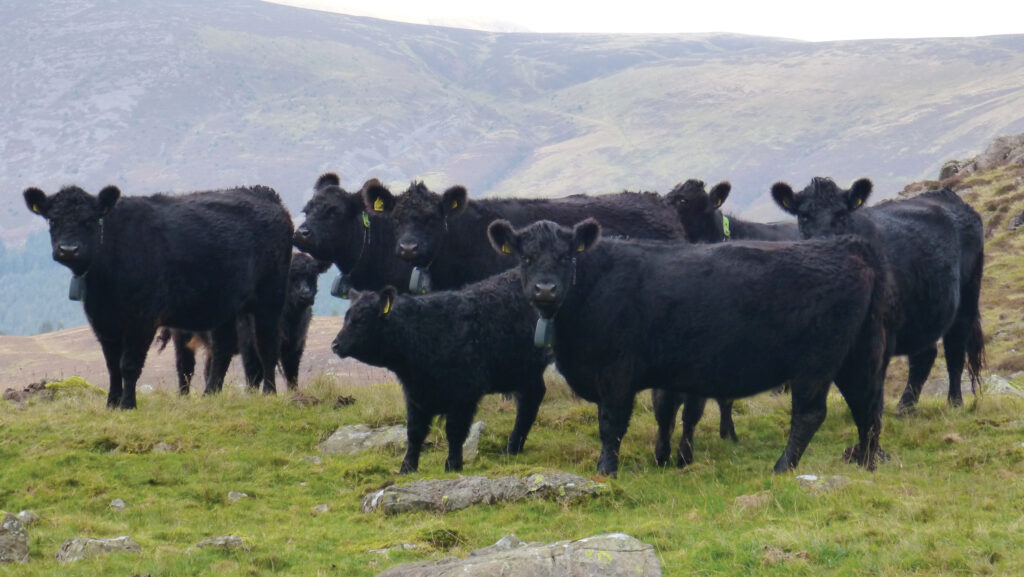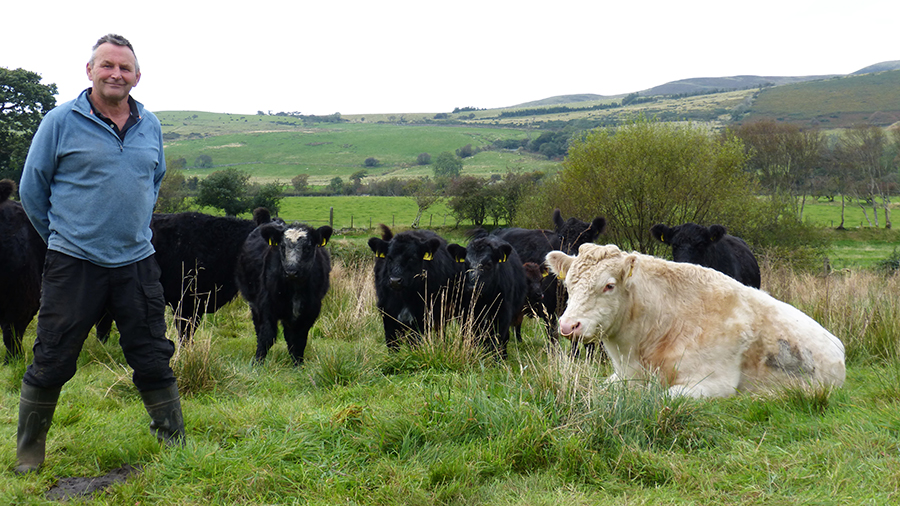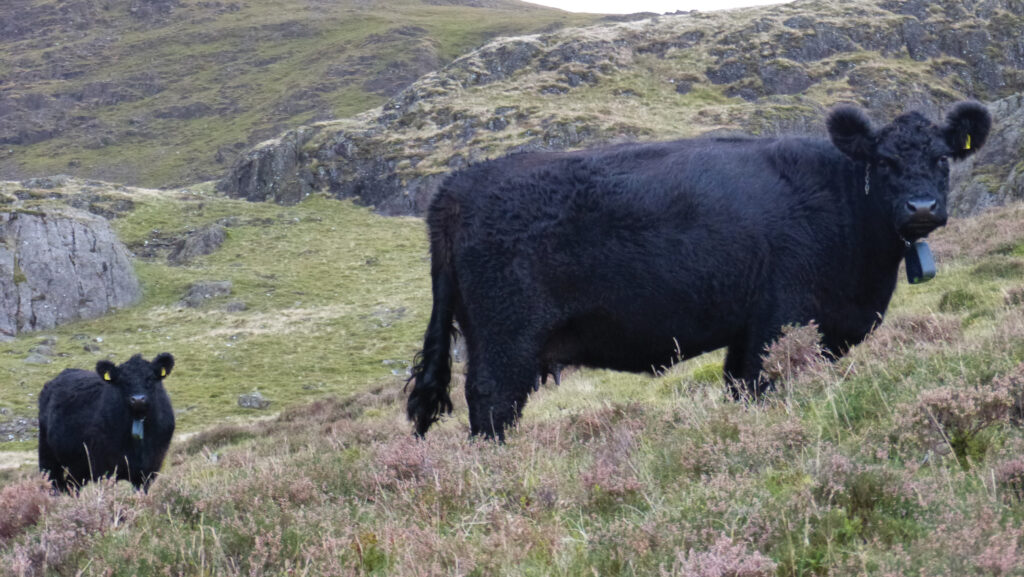Working with nature improves Lakeland farm’s profits
 © MAG/Michael Priestley
© MAG/Michael Priestley Switching from a high-input farming system to one based on minimal inputs and working with nature has improved profitability on a Cumbrian farm.
First-time farmers Richard and Alison Maxwell, of Howside, Ennerdale, have balanced off-farm employment with running a sheep and beef farm.
Since taking on a National Trust tenancy in 1998 (see “Farming timeline”), Richard, who retired from 32 years in the fire service this year, and Alison, a vet at West Lakeland Vets, Egremont, have saved £100 a cow on their total variable costs (see “Profit performance at Howside”).
See also: Why rest and recovery are essential for pasture after grazing
Turning point
Richard achieved the ambition of a lifetime in 2007 and 2008, winning first prize at the autumn suckled calf sale at Mitchells Auction Company, Cockermouth.
However, while very proud, he had an epiphany when the year-end accounts showed a loss: “Show success was not translating financially,” he says.
Worse still was the fact that he was not spending enough time with his daughter Rebecca and son William, alongside being a firefighter 35 hours a week.
Back then, selling 50 suckled calves turned over £40,000, but 20t of cake and 40t of fertiliser cost £18,000.
“That was before contractor costs for hay and two silage cuts and spreading 60,000 gallons of slurry,” explains Richard.
This was despite Howside having cubicle sheds and a slurry lagoon, which helped limit straw use to 15t a year for calving and lambing.
Farm facts: Howside
- 35 Galloway cows
- 400 Herdwick sheep
- 100ha of inbye ground at Howside
- 1,000ha farmed in total, mostly on farm business tenancies
- Extensive hill grazing, up to 800m
- Herdwicks scan at 140%, and 120% are typically sold and retained
- Prime wether lambs sold (30-34kg liveweight) between October and March at Mitchells, Cockermouth

Richard Maxwell © MAG/Michael Priestley
Transitioning
To cut costs, the Maxwells stopped buying fertiliser, saving £10,000/year (the equivalent of 12.5 calves worth £800 each).
Richard sold 12 cows and subsequently needed two fewer heifers as replacements.
A £30,000 organic conversion payment helped fund a grassland drill to stitch in clovers.
Soil sampling revealed low pH levels of 4.8-5.4 across the entire farm, which they corrected with calcium lime to help clover establishment.
In the 16 years since, there has been only a slight fall in some fields, from pH 6 to pH 5.9, with no further liming.
“This shows how soil biology and soil health can self-regulate if given a chance,” explains Richard.
With 30 breeding Galloway cows up the valley and 30 continentals at home, the Maxwells compared systems and tracked improving profitability through Newcastle University and the Farm Business Survey.
Richard says: “A continental cow ate 10 bales of silage a year, compared with a Galloway having four. At £30 a bale, that’s a £180 saving.”
By 2017, the continental cows had been dispersed.

© MAG/Michael Priestley
New system
Howside is now used as a grass-finishing unit for the cattle and wintering ground for ewes, which must all be removed in October to rest the hill in winter.
All lambing and calving there takes place outdoors.
Heifers spend their first two winters at Howside (they calve at three years of age due to the low-quality grazing on the hill), being housed for just four months.
They head to the hill in May with their first calf at foot, where they spend the rest of their lives until being culled.
The Maxwells use their pick-up and 12-foot trailer to transport calves and heifers and up to 60 sheep at a time down the three-mile track between Howside and the pens at the head of Ennerdale Water.
Diversified income
Grass-finished beef and lamb summered on Pillar and surrounding fells have proven a hit with locals.
Last year, eight steers and 20 lambs were butchered by Denneys, Kendal – all sold through word of mouth.
Surplus steers are sold at Cockermouth store cattle sales. Pure surplus Galloway heifers are sold at the Galloway Society sale at Carlisle.
Since buying a Whitebred Shorthorn bull, Blue Grey heifers have been sold at Lockerbie’s Newcastleton sale.
About 80 draft ewes are either sold in the autumn or with lambs at foot in the spring after being tupped by a Texel.
Profit performance at Howside |
||
|
Costs/GLU* |
2011/12 |
2021/22 |
|
Vet/medicine |
£37 |
£27 |
|
Forage |
£29 |
£8 |
|
Total feed |
£196 |
£154 |
|
Total variable costs |
£362 |
£262 |
|
Labour (invoiced) |
£76 |
£116 |
|
Machinery |
£446 |
£350 |
|
Rent |
£180 |
£428 |
|
Total Fixed Costs ** |
£806 |
£1,084 |
|
Profit |
-£254 |
£137*** |
|
Source: Farm Business Survey *Grazing Livestock Unit. One beef cow = 0.75GLUs and an upland ewe = 0.08 **Profit includes all farm rent and a fee for “farmer and spouse labour” of £211/GLU *** Howside has gone from 19th to 2nd in the hill rearing farm profitability table. Income includes all subsidy – which increases as a proportion of income by 24% over 10 years. |
||
Future
New projects include using virtual fencing collars to graze the 600ha (1,483-acre) hill area in the Wild Ennerdale partnership to manage more exposed, rougher areas.
The 31 Nofence collars cost £250 apiece, plus a £5/month subscription. A Farming in Protected Landscapes grant supplied 80% funding.
Richard explains: “We are learning about soil health through practical experience, research and attending a local farming event called Carbon Calling, as well as being part of Pasture for Life’s Pasture and Profit in Protected Landscapes project.
“We have learnt to graze larger mobs of livestock on smaller pieces of ground. Rest and recovery are what recharges the soil.”
Farming timeline
The Maxwells’ farming journey began with a heft of 150 Swaledales in 1997, before moving to Howside, a 43ha (106-acre) National Trust “starter farm” in 1998.
“We were small scale, so focused on high production,” recalls Richard.
The farm bred its own Mules, selling 250 Mule wethers and Texel-cross lambs at Cockermouth’s store sales, while 60 continental-cross cows criss-crossed to Limousin and British Blue sires produced suckled calves.
Sheep were lambed indoors in March and cows calved indoors through spring.
Cows were housed for seven months and calves were creep-fed from one month old.
Environmental opportunity
In 2001, the Maxwells took on a 350ha (865-acre) heft of 200 Herdwicks 7.5 miles up the valley on Pillar, the ninth highest hill in England, on behalf of the National Trust.
Three years later, the Forestry Commission (on behalf of the Wild Ennerdale partnership) approached the Maxwells about reintroducing cattle on 145ha (358 acres) in Ennerdale after a 50-year break.
The idea was to use cattle to increase floral diversity through grazing less selectively and to live on the hill 12 months of the year.
So, eight bulling heifers and an in-calf mature cow – to act as a matriarch – were bought and a bull rented from William McMorran’s Miefield herd, Kirkcudbright.
“I started noticing how the dominant cow would bellow and move the herd away from flies or to shelter or sweeter grasses,” says Richard.
“Several times I thought I’d lost a cow, but she’d hidden her newborn calf in the woods for a fortnight – so different to the cows at home, where we did everything for them.”
Further opportunity
In 2013, the Forestry Commission offered the Maxwells a tenancy on 600ha (1,483 acres) of Ennerdale at Gillerthwaite, adding another heft of Herdwicks and 12 more cows.
